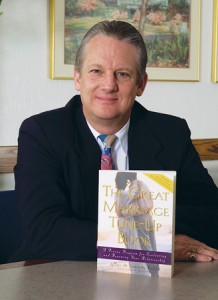By Julie H. Walker, ’93
WHILE Hollywood and Hallmark may suggest otherwise, the secret to a successful long-term relationship isn’t all romance and candlelight, says a BYU researcher who has spent 22 years studying what makes a happy marriage.
“Romance is overrated,” jokes BYU professor and marriage therapist Jeffry H. Larson, ’71, author of The Great Marriage Tune-up Book. He says research shows that romantic love is just one component of a successful marriage.
“Our society sells romance and Valentine’s Day, and we don’t see the reality. After they are married, most couples are really disillusioned when the romance begins to simmer down and they start to deal with everyday issues,” he says.
Larson says studies of couples who have been married for 50 years or more say it wasn’t the romance that kept them together over time, but rather what they describe as a deep, caring friendship and the ability to enjoy each other’s company.
“Happily married people enjoy doing things together, have similar interests, they’re good friends,” says Larson.
While Larson says romantic love is important because it brings the couple together and establishes a level of intimacy, over-romanticized expectations about married life can be difficult for new couples to reconcile with reality. Research shows that most couples go through several predictable phases in their relationship, including a post-honeymoon period characterized by “disillusionment” and “distraction.”
“Over time, not only do we expect more of each other, but we fail to understand that our love for each other is going to change too, from a romantic love to a more mature companionate love.”
Fueled by a myth that romance is the key to sustaining the relationship, many couples will never successfully navigate the transition phase, he says. National statistics show that half of all divorces occur in the first seven years of marriage, many within the first two years.
“Daily challenges take a toll on us physically and emotionally and the vitality of our relationship suffers. These transitions are not inherently bad—they are an unavoidable part of life—but they are often more difficult than we thought they would be.”
Larson says it’s not uncommon for couples to get “in a rut” after a few years of marriage. When love has waned, he says couples can revive the marriage by: 1) thinking about a time in the past when you felt love and resuming the behaviors, attitudes, and rituals that worked before; 2) giving love to get love, regardless of where your spouse is along the way; and 3) setting goals to improve the love in your marriage by increasing nourishing behaviors and avoiding destructive behaviors.
Nourishing behaviors include sharing feelings regularly, thoughtfulness (gestures, unexpected gifts), compliments, sacrificing for each other, kind words, empathy, prioritizing your marriage, accepting your partner’s faults, and showing respect.
“You have to change the way you do things, develop new ideas, interests, or activities. It involves prioritizing your marriage more, learning how to connect more with each other, and finding out what makes your spouse feel valued, unique, and important.”









